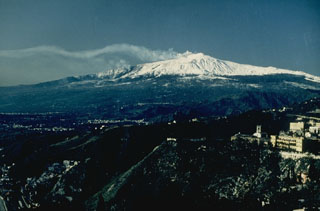Report on Etna (Italy) — 28 May-3 June 2025
Smithsonian Institution / US Geological Survey
Weekly Volcanic Activity Report, 28 May-3 June 2025
Managing Editor: Sally Sennert.
Please cite this report as:
Global Volcanism Program, 2025. Report on Etna (Italy) (Sennert, S, ed.). Weekly Volcanic Activity Report, 28 May-3 June 2025. Smithsonian Institution and US Geological Survey.
Etna
Italy
37.748°N, 14.999°E; summit elev. 3357 m
All times are local (unless otherwise noted)
The Sezione di Catania - Osservatorio Etneo (INGV) reported that tremor amplitude at Etna began to increase starting at around 0000 on 2 June and reached high levels by 0250. Infrasound activity slightly increased at around 0230 and around 0350 Strombolian activity at the SE Crater was visible in webcam images. The Aviation Color Code was raised to Yellow (the second highest color on a four-color scale) at 0323, to Orange at 0402, and to Red at 0839. Ash emissions at this time were confined to the summit area, though Strombolian activity intensified through the morning and became almost continuous. Lava overflowed the E rim of the crater and produced a small lava flow towards the Valle del Bove. A larger flow traveled S. Infrasound activity was both frequent and intense. Lava fountaining began at SE Crater at around 1000 and both lava flows advanced; the flows branched and were 2 km long. Ash plumes rose above the summit and drifted W. Minor ashfall was reported in the Piano Vetore area (6 km SSW) prior to 1100.
A fissure opened on the upper NE flank of SE Crater at around 1100 and produced a lava flow that advanced N, according to the Associazione Italiana di Vulcanologia ETS (AIV ETS). Emissions of gas, ash, and white-to-reddish-brown steam rose from that same area. The emissions progressively intensified for 20 minutes. INGV noted that at 1124 a pyroclastic flow was likely generated from a collapse of material at the N side of the SE Crater cone and traveled NE, reaching the N wall of the Valle del Leone (the upper part of the Valle del Bove). AIV ETS stated that the pyroclastic flow interacted explosively with buried snow and traveled 2 km in one minute. Ash rose along the pyroclastic flow to about 3 km above the summit and was visible across eastern Sicily. According to INGV fine reddish ash drifted WNW and fell in Cesarò (27 km WNW) and Bronte (15 km WNW). A lava flow from the base of the N flank of SE Crater advanced N. News article noted that many tourists were on the flanks and were seen running away from the pyroclastic flow; tourist visits to the volcano were halted. About 20 percent of flights into Catania were delayed. Strombolian activity decreased during the afternoon and at 1600 the Aviation Color Code was lowered to Orange. Minor ash emissions continued but dispersed near the summit area; the Aviation Color Code was lowered Yellow at 1656. Activity ceased and at 2011 the Aviation Color Code was lowered to Green.
Geological Summary. Mount Etna, towering above Catania on the island of Sicily, has one of the world's longest documented records of volcanism, dating back to 1500 BCE. Historical lava flows of basaltic composition cover much of the surface of this massive volcano, whose edifice is the highest and most voluminous in Italy. The Mongibello stratovolcano, truncated by several small calderas, was constructed during the late Pleistocene and Holocene over an older shield volcano. The most prominent morphological feature of Etna is the Valle del Bove, a 5 x 10 km caldera open to the east. Two styles of eruptive activity typically occur, sometimes simultaneously. Persistent explosive eruptions, sometimes with minor lava emissions, take place from one or more summit craters. Flank vents, typically with higher effusion rates, are less frequently active and originate from fissures that open progressively downward from near the summit (usually accompanied by Strombolian eruptions at the upper end). Cinder cones are commonly constructed over the vents of lower-flank lava flows. Lava flows extend to the foot of the volcano on all sides and have reached the sea over a broad area on the SE flank.
Sources: Sezione di Catania - Osservatorio Etneo (INGV), Toulouse Volcanic Ash Advisory Centre (VAAC), National Public Radio (NPR), New York Times, Associazione Italiana di Vulcanologia ETS (AIV ETS)

